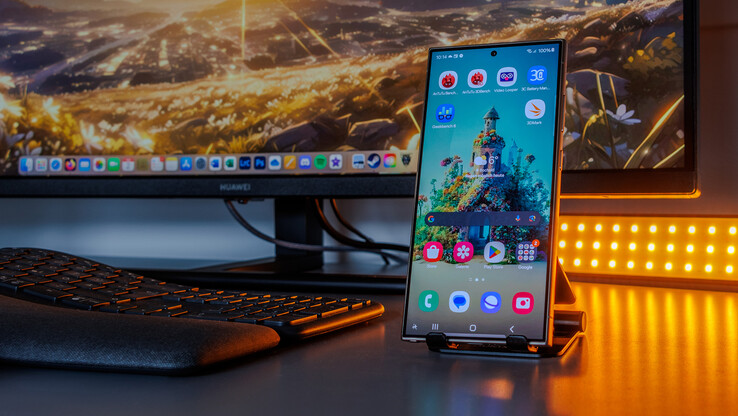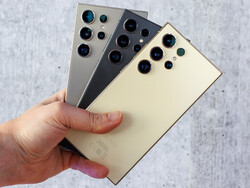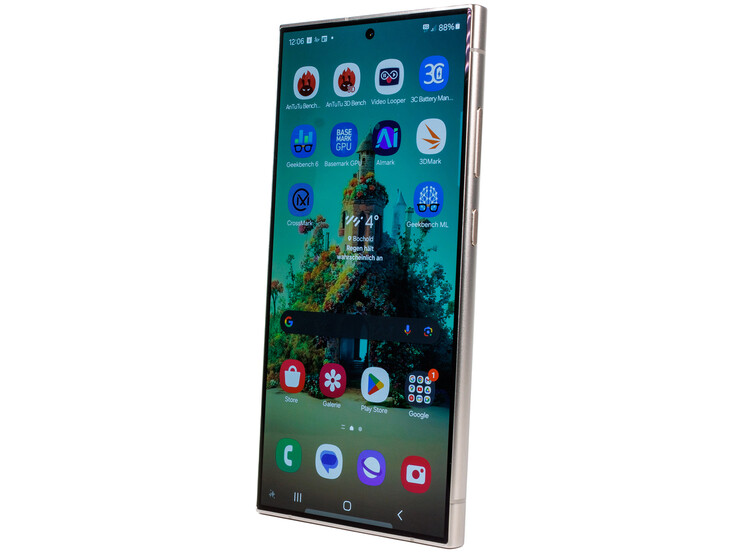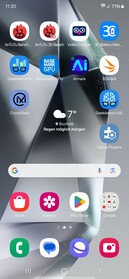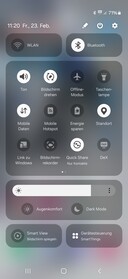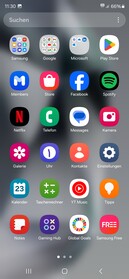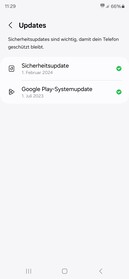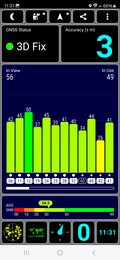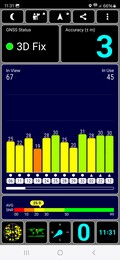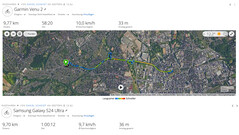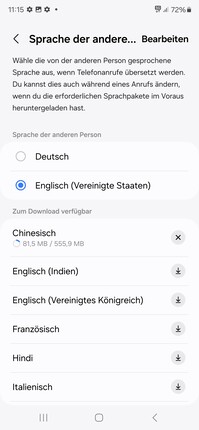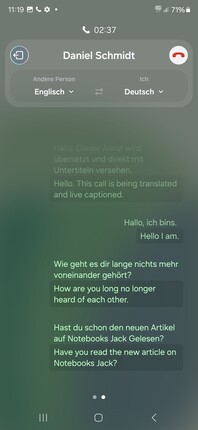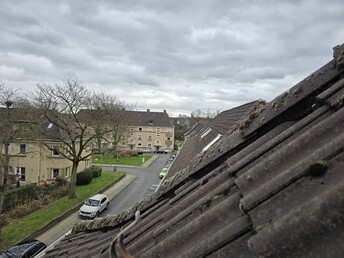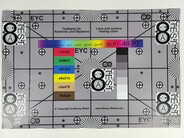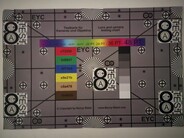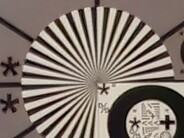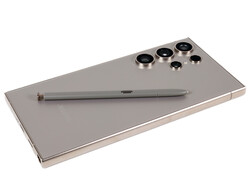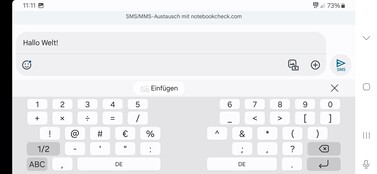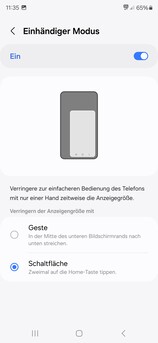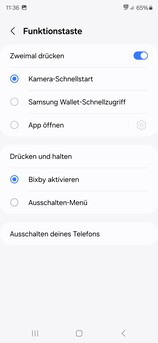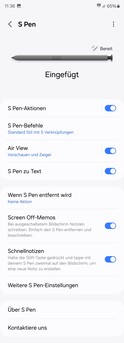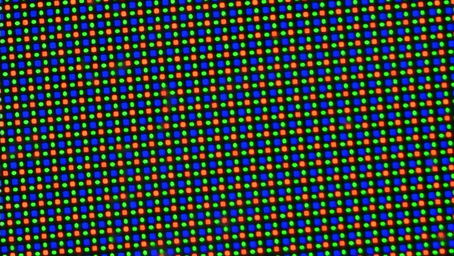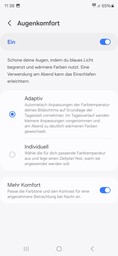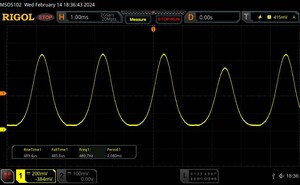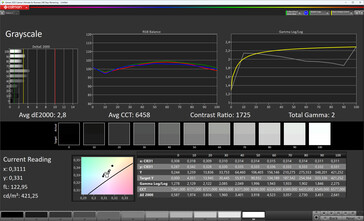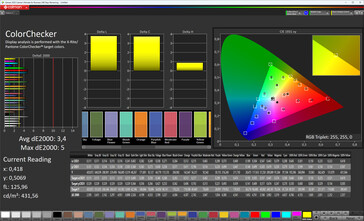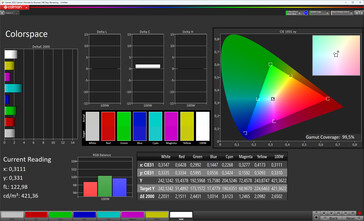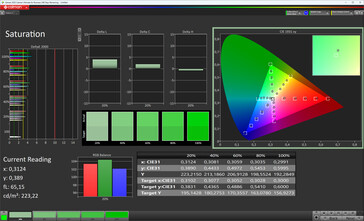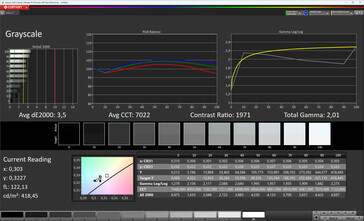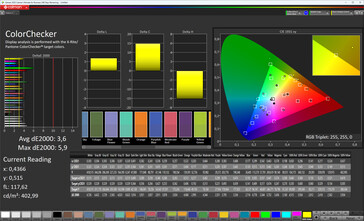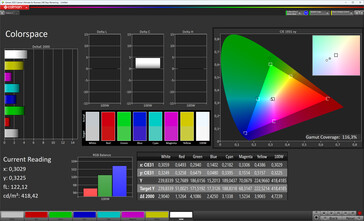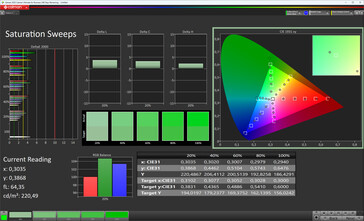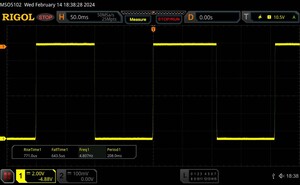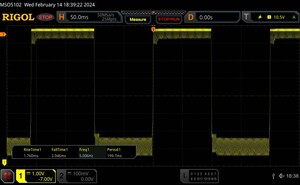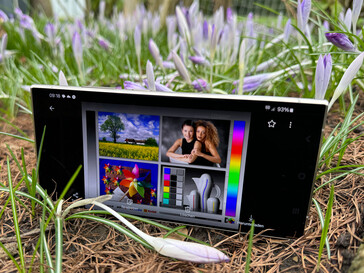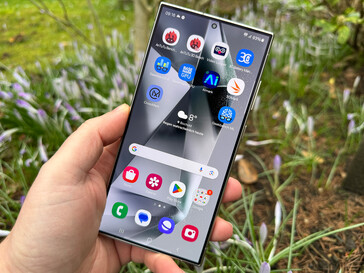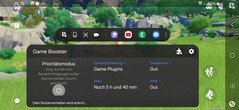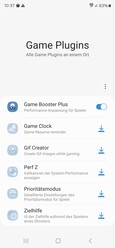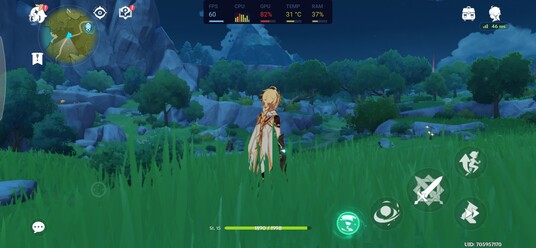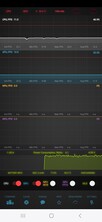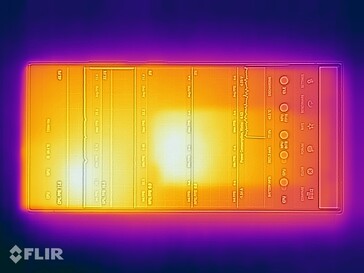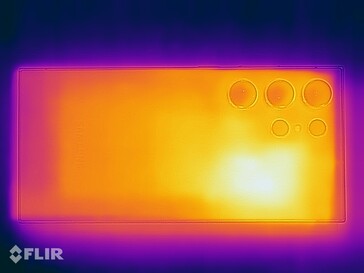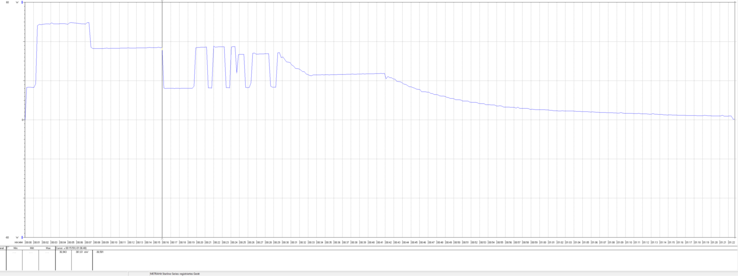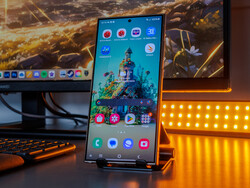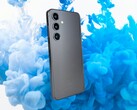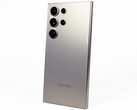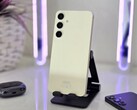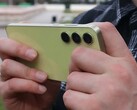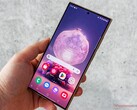Samsung Galaxy S24 Ultra review: The ultimate smartphone becomes an AI smartphone
The Samsung Galaxy S24 Ultra is the direct successor to the Galaxy S23 Ultra. Visually, it is very similar to its predecessor, but there are a few subtle differences. For the new generation, Samsung uses titanium alloy for the frame for the first time together with the previously exclusive Corning Gorilla Armor glass. Another exclusive feature is the SoC, which of course is the Qualcomm Snapdragon 8 Gen 3 for Galaxy. The camera has also been given a new periscope zoom, but the other sensors remain unchanged.
The Galaxy S24 Ultra starts at $1300 and is therefore $100 more expensive than its predecessor, but also offers more RAM. Samsung offers three configurations:
| Configuration | Price (RRP) |
|---|---|
| 12/256 GB | $1299.99 |
| 12/512 GB | $1419.99 |
| 12/1024 GB | $1659.99 |
The 1 TB version is only available from Samsung.
Possible competitors in comparison
Rating | Date | Model | Weight | Drive | Size | Resolution | Price |
|---|---|---|---|---|---|---|---|
| 91.1 % v7 (old) | 05 / 2024 | Samsung Galaxy S24 Ultra SD 8 Gen 3 for Galaxy, Adreno 750 | 232 g | 256 GB UFS 4.0 Flash | 6.80" | 3120x1440 | |
| 89.4 % v7 (old) | 12 / 2023 | Xiaomi 14 Pro SD 8 Gen 3, Adreno 750 | 223 g | 256 GB UFS 4.0 Flash | 6.73" | 3200x1440 | |
| 91.1 % v7 (old) | 12 / 2023 | Apple iPhone 15 Pro Max A17 Pro, A17 Pro GPU | 221 g | 256 GB NVMe | 6.70" | 2796x1290 | |
| 90.1 % v7 (old) | 07 / 2023 | Honor Magic5 Pro SD 8 Gen 2, Adreno 740 | 219 g | 512 GB UFS 4.0 Flash | 6.81" | 2848x1312 | |
| 89.9 % v7 (old) | 06 / 2023 | Sony Xperia 1 V SD 8 Gen 2, Adreno 740 | 187 g | 256 GB UFS 4.0 Flash | 6.50" | 3840x1644 | |
| 89.4 % v7 (old) | 05 / 2023 | Motorola Edge 40 Pro SD 8 Gen 2, Adreno 740 | 199 g | 256 GB UFS 4.0 Flash | 6.67" | 2400x1080 | |
| 89 % v7 (old) | 12 / 2023 | Google Pixel 8 Pro Tensor G3, Mali-G715 MP7 | 213 g | 128 GB UFS 3.1 Flash | 6.70" | 2992x1344 |
Case - Titanium and Gorilla Armor glass for the Galaxy S24 Ultra
The Samsung Galaxy S24 Ultra uses a titanium alloy frame for the first time, but this does not have a significant impact on the weight, as it is only one gram lighter than its predecessor. Samsung specifies a height of 8.6 millimeters, which is confirmed by our measurements. The small camera lenses protrude 1.2 millimeters, the larger ones 2.15 millimeters. If the S24 Ultra is lying on a table, for example, it can be very wobbly.
All titanium frames have a matte finish, but are also colored differently depending on the color chosen. This year, there are four colors to choose from: Titanium Gray, Titanium Black, Titanium Violet and Titanium Yellow, all of which are based on minerals. Samsung also offers the exclusive Titanium Blue, Green and Orange colors in its own store.
The workmanship is first class: the gaps are tight and even, and the smartphone defies torsional stress quite well, only giving a quiet creak when we attempt to twist it. It is overall very robust and sits comfortably in the hand despite its weight. It also makes a very high-quality impression both visually and haptically. The Corning Gorilla Armor glass is said to be considerably more resistant than its predecessor and adorns both the front and back.
The Galaxy smartphone is again certified as dust and waterproof in accordance with IP68. However, Samsung limits the latter to a depth of 1.5 meters in water for 30 minutes. The card slot and its cover is flush with the frame and can hold up to two nano SIM cards.
Features - Galaxy S24 Ultra without any real gaps
The Samsung Galaxy S24 Ultra once again offers a USB-C port as a physical interface, which supports the 3.2 (Gen. 1) standard. Thanks to USB OTG, not only can the smartphone be charged, but peripherals, headphones, storage media etc. can also be connected to it. For the copy test, we connected an Asus ROG Strix Arion Case (USB 3.2 Gen. 2) with a Samsung 980 Pro to the smartphone and achieved a data transfer rate of 227.97 MB/s. A decent value, but not outstanding. The connected storage media can be formatted with FAT, FAT32 or exFAT. For NTFS, Samsung only supports reading the disk drives.
The USB port also supports wired image output. The user has the choice of mirroring the panel content or switching to DeX mode. The latter is a desktop interface with some technical optionality. At best it can be run in Full HD. Thick black edges remain, especially on WQHD screens. Wireless alternatives may well be a better choice here.
Otherwise, the Galaxy S24 Ultra also offers Bluetooth 5.3, NFC and an ultra-wideband chip (UWB). A pity that Samsung has not yet opted for modern Bluetooth 5.4 LE. Otherwise, the features of the S24 Ultra are quite complete for a high-end smartphone. Only the Xperia 1 V offers an audio jack and microSD support in this segment; the only criticism is the lack of an IR blaster.
Software - AI Phone with seven years of updates
The Samsung Galaxy S24 Ultra comes with Android 14 and in-house user interface One UI 6.1. Seven years of updates are promised. Alongside the current Pixel smartphones, Samsung is the only manufacturer with such a long update promise. The security updates on our test device were from February 1, 2024, and so very much up to date. The S24 Ultra only lags behind in terms of Play security patches, using those from July 2023
The real highlights, however, are the numerous new functions of One UI 6.1, which provides a slew of new AI features and are intended to turn the Samsung smartphone into an AI phone. Similarly to Google, Samsung is taking a hybrid approach, leaving only several functions on the device and outsourcing more complex tasks to the cloud, which is why it is mandatory to have a Samsung account. Unlike Google, however, the Koreans openly communicate from the outset which AI functions require a cloud connection. It is also possible to deactivate this in the settings so that all personal data remains on the smartphone.
The new translation tools are among the functions that are carried out directly on the smartphone. You can translate messages directly in Messenger, similar to what we already know from the Google Pixel, but with Samsung the original text can still be displayed. The best thing is that this now also works with phonecalls. Texts written with the Samsung keyboard can now not only be checked for spelling and grammar, but also suggestions for stylistic improvements can be made. The Samsung browser can summarize long texts on websites, while unwanted people, objects or reflections can be easily retouched in the photo app. The heavily-advertised AI makes all of this and much more possible.
This also includes 'Circle to Search', which simply draws a circle around the object on the screen and Google then searches for relevant entries online. This already works quite well and makes it easier to identify a desired product or an unknown building. However, it is not yet completely free from error. For example, a photographed church in Munich, Germany, was mistaken for one in Basel, Switzerland, which should have been obvious from the location data.
Nevertheless, the many new functions certainly offer added value in everyday life or at least speed it up noticeably.
Communication and GNSS - WiFi 7 at last
The Galaxy S24 Ultra is the first Samsung smartphone to support the current WiFi 7 standard, including the 6 GHz band. In tests with our Asus ROG Rapture GT-AXE11000 (Wi-Fi 6E) reference router, the transfer rates were not flawless, but experience has shown that Samsung will improve this via an update. We will test this again later, hopefully with WiFi 7.
On the other hand, the WiFi signal strength is very good and the S24 Ultra also impresses in terms of range. A change of floor is not noticeable, nor is the change of access point in a mesh system.
Not much has changed in terms of mobile communications. The Galaxy smartphone supports numerous frequency bands and so should be able to establish a powerful connection almost anywhere. In a metropolitan environment, reception characteristics are very good and leave no room for criticism.
| Networking | |
| Samsung Galaxy S24 Ultra | |
| iperf3 receive AXE11000 | |
| iperf3 transmit AXE11000 | |
| iperf3 transmit AXE11000 6GHz | |
| iperf3 receive AXE11000 6GHz | |
| Xiaomi 14 Pro | |
| iperf3 receive AXE11000 | |
| iperf3 transmit AXE11000 | |
| iperf3 transmit AXE11000 6GHz | |
| iperf3 receive AXE11000 6GHz | |
| Apple iPhone 15 Pro Max | |
| iperf3 receive AXE11000 | |
| iperf3 transmit AXE11000 | |
| iperf3 transmit AXE11000 6GHz | |
| iperf3 receive AXE11000 6GHz | |
| Honor Magic5 Pro | |
| iperf3 receive AXE11000 | |
| iperf3 transmit AXE11000 | |
| Sony Xperia 1 V | |
| iperf3 receive AXE11000 | |
| iperf3 transmit AXE11000 | |
| iperf3 transmit AXE11000 6GHz | |
| iperf3 receive AXE11000 6GHz | |
| Motorola Edge 40 Pro | |
| iperf3 transmit AXE11000 6GHz | |
| iperf3 receive AXE11000 6GHz | |
| Google Pixel 8 Pro | |
| iperf3 receive AXE11000 | |
| iperf3 transmit AXE11000 | |
| iperf3 transmit AXE11000 6GHz | |
| iperf3 receive AXE11000 6GHz | |
| Samsung Galaxy S23 Ultra | |
| iperf3 receive AXE11000 | |
| iperf3 transmit AXE11000 | |
| iperf3 transmit AXE11000 6GHz | |
| iperf3 receive AXE11000 6GHz | |
| Average of class Smartphone | |
| iperf3 receive AXE11000 | |
| iperf3 transmit AXE11000 | |
| iperf3 transmit AXE11000 6GHz | |
| iperf3 receive AXE11000 6GHz | |
Samsung lists all global networks as supported satellite networks; only the local NavIC for India is not supported. We also found a few gaps in frequency band support: for example, E5b is missing for Galileo and B2b for BeiDou. Localization works quickly, even indoors, with good signal strength.
On a bike ride, we compared the tracking capabilities of the S24 with those of the Garmin Venu 2. Neither device delivers flawless results, but the Galaxy S24 Ultra is a little more accurate between houses, while the fitness smartwatch performs slightly better around the lake. In any case, the Samsung smartphone is ideally equipped for all navigational tasks.
Telephony and voice quality
The Samsung Galaxy S24 Ultra can accommodate two nano SIM cards or alternatively use two eSIMs. Functions such as WiFi calls and VoLTE are supported.
The voice quality is very good when held to the ear. Our call participants are easy to understand and the S24 user's voice is reproduced very naturally. Background noise is filtered out very reliably. However, the user's voice seems a little cramped when there is a lot of noise, but the background noise is not audible. In speaker mode, the Samsung smartphone delivers good quality with a good microphone range - one and a half meters away from the smartphone poses no issue.
Real-time translation of phonecalls must first be activated in the settings. A corresponding field then appears in the chat window, where the translation takes place. The corresponding language models, which are around 0.5 GB each in size, must first be downloaded. The language selection is quite large and includes English, Korean, Chinese, German, Spanish, Polish and a few more. The spoken languages are not automatically recognized, but must be set beforehand.
Upon starting a translated call, the receiver gets an announcement that it will begin shortly. The spoken language can still be heard, but a machine voice then speaks the translation. This works quite well for simple conversations and is also recorded in a transcript. During the conversation, however, care should be taken to ensure that the environment is quiet, as the noise suppression does not seem to work at all or only to a very limited extent, meaning that what is otherwise spoken by bystanders may also be translated. The function also has problems with technical terms or mixing languages. But it is still a great help, especially if there is simply no other way to fall back on a shared language.
Cameras - Only the periscope optics get a real upgrade
The front camera of the Samsung Galaxy S24 Ultra has not changed technically compared to the S23 Ultra and only benefits from the more modern ISP and revised software. It has autofocus and can record videos in Ultra HD at up to 60 FPS. In good lighting conditions, it takes appealing pictures, but these are somewhat paler compared to the main lens on the back.
The back component still consists of four lenses, but only the periscope camera has been upgraded. It is no longer a 10x optical zoom like in the S23 Ultra, but has been reduced to 5x magnification. In return, the sensor is larger, although still not a giant, and has a much finer resolution of 50 MP. This shouldn't affect quality at longer focal lengths: Samsung even speaks of an almost loss-free hybrid zoom at 10x magnification and the digital zoom can also extend the focal length up to 2300 mm (100x).
The quality of the S24 Ultra Zoom is impressive. Even at 10x magnification, images are still very appealing. Things only get fuzzy with the 3x zoom, which also has a dedicated lens and drops visibly in quality the further one zooms in. Why Samsung didn't give this an upgrade is a bit of a mystery to us. The higher zoom levels may be suitable for social media, but certainly not for high-quality prints, especially beyond 30x magnification. But in everyday life, the far-reaching zoom is still practical for making signs or notices legible from a distance.
Zoom von 0,6x bis 100x


Samsung has not added a new sensor to the ultra-wide angle either. This was already noticeable in its predecessor and does not cut a better figure here either. However, the integrated macro function is practical.
The main camera uses the in-house 200 MP sensor from last year. The blurred spots of the S23 Ultra seem to be a thing of the past, for we found none on our test device. The Galaxy S24 Ultra generates photos in 12 MP thanks to pixel binning technology. These can also be created in 50 MP, but this is only recommended in good lighting conditions and without backlighting (see comparison). In Pro mode, 24 MP is also available. In general, Samsung offers many modes and setting options. The additional Expert RAW app can be used for astrophotography, among other things.
In the bunny photo, the S24 Ultra almost tends to burn out areas on the white shirt. Although very bright, the details remain visible. Nevertheless, Samsung could have made the details here a little more homogeneous. Otherwise, the Galaxy smartphone shines with a high dynamic range and the ability to create ultra-HDR photos. The sharpening is occasionally very strong and if shadows are accentuated up by the automatic function, this can sometimes be at the expense of the details. Nevertheless, Samsung manages to achieve good imaging performance overall.
In low light, the Galaxy S24 Ultra automatically switches to night mode and usually selects slightly longer exposure times than the competition. But even at three seconds, photos can still be taken by hand and turn out appealingly well. At this point we should mention the improved 'Live View', as there is a world of difference compared to the S23 Ultra. And when it comes to image stabilization, the S24 Ultra is the absolute best, even at long focal lengths.
| Mode | Aspect Ratio | Resolution |
|---|---|---|
| Photo | Full, 1:1, 16:9, 4:3 | 12 / 50 / 200 MPix |
| Pro | Full, 1:1, 16:9, 4:3 | 12 / 50 MPix |
| Expert RAW | 4:3 | 12 / 24 / 50 MPix |
| Video | Full, 1:1, 16:9 | HD (30FPS), Full HD (30/60 FPS), Ultra HD (30/60 FPS), 8k (30 FPS) |
| Pro Video | Full, 1:1, 16:9, 21:9 | HD (30FPS), Full HD (24/30/60/120 FPS), Ultra HD (24/30/60/120 FPS), 8k (24/30 FPS) |
Image comparison
Choose a scene and navigate within the first image. One click changes the position on touchscreens. One click on the zoomed-in image opens the original in a new window. The first image shows the scaled photograph of the test device.
Main cameraMain cameraUltra wide angle5x zoomLow light photoThe Samsung Galaxy S24 Ultra supports numerous resolutions for videography from 720p to Ultra HD to 8k. The smartphone is also flexible in terms of refresh rates and delivers between 24 and 120 frames per second, including support for HDR10+. Higher frame rates are possible in slow motion mode.
We liked the recordings taken in automatic mode. In our test recording in Ultra HD (60 FPS) and activated HDR10+, we got good results, but the backlight compensation was only average here, which came at the expense of the contrasts.
Under controlled lighting conditions, the Samsung Galaxy S24 Ultra achieves good color reproduction without any major outliers. Only the blue tones show a slightly increased DeltaE.
Our test chart is displayed well (even with the full 200 MP) and many details are retained. However, the aggressive sharpening also causes a few details to disappear in the peripheral areas.
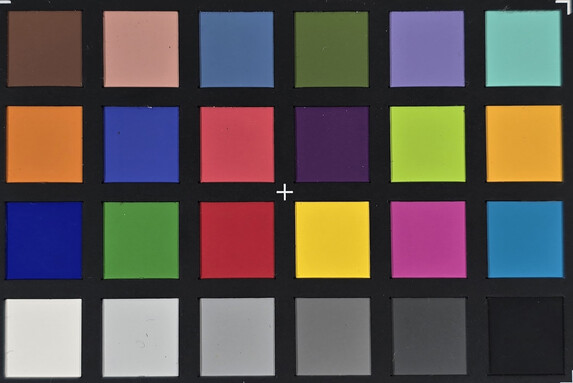
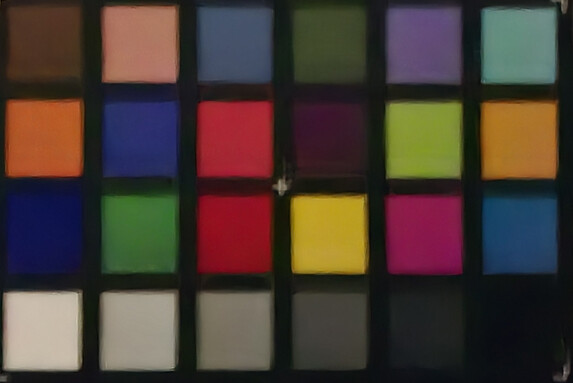
Accessories and warranty - S24 Ultra comes with USB cable only
In addition to a USB-C cable and a SIM needle, the scope of delivery of the Samsung Galaxy S24 Ultra only includes a few pieces of paper. Various cases, power supplies or charging stations are also available as options.
Samsung provides a 12-month limited warranty for the Galaxy S24 Ultra in the US, which can be supplemented with the Care+ insurance package. This can be purchased for either 24 or 36 months and can include additional theft protection. Prices range from monthly plans of 8$ for a term of 36 months to single-pay plans from $129 to $349 for a term of 24 months. The deductible ranges from $99 to $199 in the event of theft and is limited to three claims per year.
Input devices & operation - AI Phone with S Pen
The Samsung Galaxy S24 Ultra does without a screen protector and is the first smartphone to utilize Corning Gorilla Armor protective glass. This offers very good gliding properties and screen inputs are implemented quickly and accurately.
You can also use the S Pen, which can be stowed away in the case, instead of your own finger. The active stylus supports up to 4096 pressure levels, is connected via Bluetooth and has an input latency of nine milliseconds. The S Pen again offers many additional functions, but has not undergone any significant changes since the Galaxy Note20 Ultra.
Biometric security is guaranteed by a high-quality ultrasonic sensor that quickly and reliably detects the stored finger. Additionally or alternatively, a less secure facial recognition can be used via the front camera, which also works very quickly, but takes longer in very dark environments or even sometimes refuses access to the smartphone.
The Galaxy phone's linear vibration motor provides crisp haptic feedback and is very quiet.
Display - Super bright and hardly reflects
The 6.8-inch (17.27 cm) Dynamic AMOLED x2 display of the Galaxy S24 Ultra is now flat at the edges, which is particularly convenient when working with the S Pen. The panel has a WQHD+ resolution at best, but can also be operated at a lower pixel density to conserve energy. Thanks to LTPO functionality, the system can dynamically adjust the refresh rate between 1 and 120 Hz. Dolby Vision is lacking, but other HDR standards are supported.
Samsung has increased the display brightness compared to the S23 Ultra and claims a brightness of up to 2500 cd/m². On a pure white display with the ambient light sensor activated, the S24 Ultra emits 1317 cd/m² (+200 cd/m²) in the center of the image. If light and dark areas are evenly distributed (APL18), the claim is well exceeded with a result of 2747 cd/m² (+1,000 cd/m. We even measured 2942 cd/m² during HDR playback.
Users who do without the ambient light sensor will have 419 cd/m² available with full white; this value then climbs to 503 cd/m² with APL18. The luminosity can be increased to 726 or 881 cd/m² via the toggle switch for Additional brightness.
Samsung does a lot of things right to ensure eye-friendly operation: With the EyeComfort function, the color temperature of the display can be automatically adapted by the system to the current lighting conditions in order to keep the blue light as low as possible. In the dark, the very low minimum luminance (1.01 cd/m²) puts as little strain on the eyes as possible and can even be reduced to 0.65 cd/m² via the extra dimming option.
Samsung has even improved the PWM dimming and doubled the frequency, but this still doesn't make it flicker-free; sensitive people may still find this irritating. No temporal dithering was detected.
| |||||||||||||||||||||||||
Brightness Distribution: 94 %
Center on Battery: 1317 cd/m²
Contrast: ∞:1 (Black: 0 cd/m²)
ΔE ColorChecker Calman: 3.4 | ∀{0.5-29.43 Ø4.77}
ΔE Greyscale Calman: 2.8 | ∀{0.09-98 Ø5}
99.5% sRGB (Calman 2D)
Gamma: 2
CCT: 6458 K
| Samsung Galaxy S24 Ultra Dynamic AMOLED 2X, 3120x1440, 6.8" | Apple iPhone 15 Pro Max OLED, 2796x1290, 6.7" | Sony Xperia 1 V AMOLED, 3840x1644, 6.5" | Motorola Edge 40 Pro P-OLED, 2400x1080, 6.7" | Google Pixel 8 Pro OLED, 2992x1344, 6.7" | Vivo X100 Pro AMOLED, 2800x1260, 6.8" | |
|---|---|---|---|---|---|---|
| Screen | 20% | 12% | 17% | 25% | 37% | |
| Brightness middle (cd/m²) | 1317 | 1102 -16% | 934 -29% | 1056 -20% | 1510 15% | 1392 6% |
| Brightness (cd/m²) | 1365 | 1102 -19% | 948 -31% | 1055 -23% | 1467 7% | 1360 0% |
| Brightness Distribution (%) | 94 | 98 4% | 96 2% | 92 -2% | 92 -2% | 84 -11% |
| Black Level * (cd/m²) | ||||||
| Colorchecker dE 2000 * | 3.4 | 1.1 68% | 1.5 56% | 1.28 62% | 1.1 68% | 0.6 82% |
| Colorchecker dE 2000 max. * | 5 | 3.1 38% | 4 20% | 2.85 43% | 3.8 24% | 1.3 74% |
| Greyscale dE 2000 * | 2.8 | 1.6 43% | 1.3 54% | 1.7 39% | 1.7 39% | 0.9 68% |
| Gamma | 2 110% | 2.19 100% | 2.2 100% | 2.206 100% | 2.23 99% | 2.25 98% |
| CCT | 6458 101% | 6555 99% | 6384 102% | 6320 103% | 6670 97% | 6540 99% |
* ... smaller is better
Screen Flickering / PWM (Pulse-Width Modulation)
| Screen flickering / PWM detected | 480 Hz | ||
The display backlight flickers at 480 Hz (worst case, e.g., utilizing PWM) . The frequency of 480 Hz is relatively high, so most users sensitive to PWM should not notice any flickering. However, there are reports that some users are still sensitive to PWM at 500 Hz and above, so be aware. In comparison: 53 % of all tested devices do not use PWM to dim the display. If PWM was detected, an average of 8084 (minimum: 5 - maximum: 343500) Hz was measured. | |||
Series of measurements at a fixed zoom level and different brightness settings
The reproduction accuracy of colors and grayscale has become progressively worse in the Samsung Ultra series over the last two years. While the S22 Ultra (DeltaE: grayscale 1.3 / colors 1.2) still delivered exemplary values, the S23 Ultra (dE 2.3 / 2.2) was worse, although still at a very good level. However, the S24 Ultra (dE 2.8 / 3.4) falls a little behind by high-end standards and also lags behind in the comparison field. However, this is not noticeable in everyday use.
The color mode Natural delivers the best results and covers the selected sRGB color space almost completely. The Vivid mode is calibrated a little cooler and uses an extended sRGB color space, while the S23 Ultra almost fully covers the much larger DCI-P3 color space. A rather incomprehensible development at Samsung, as photos taken with the S24 Ultra also use DCI-P3 as the working color space. An optimal representation of the colors is certainly not achieved here.
Display Response Times
| ↔ Response Time Black to White | ||
|---|---|---|
| 1.41 ms ... rise ↗ and fall ↘ combined | ↗ 0.771 ms rise | |
| ↘ 0.6435 ms fall | ||
| The screen shows very fast response rates in our tests and should be very well suited for fast-paced gaming. In comparison, all tested devices range from 0.1 (minimum) to 240 (maximum) ms. » 7 % of all devices are better. This means that the measured response time is better than the average of all tested devices (20.2 ms). | ||
| ↔ Response Time 50% Grey to 80% Grey | ||
| 3.8 ms ... rise ↗ and fall ↘ combined | ↗ 1.76 ms rise | |
| ↘ 2.046 ms fall | ||
| The screen shows very fast response rates in our tests and should be very well suited for fast-paced gaming. In comparison, all tested devices range from 0.165 (minimum) to 636 (maximum) ms. » 14 % of all devices are better. This means that the measured response time is better than the average of all tested devices (31.6 ms). | ||
We really like the viewing angle stability of the Samsung Galaxy S24 Ultra. Only at very flat viewing angles is a loss of brightness noticeable and the display becomes a little cooler. Other smartphones can do this a little better, but we never found this annoying.
Performance - Snapdragon 8 Gen 3 for Galaxy in the S24 Ultra
The Galaxy S24 Ultra is once again powered by a special edition of Qualcomm's top SoC, the Snapdragon 8 Gen 3 for Galaxy. This is quite similar to the conventional Snapdragon 8 Gen 3, but Samsung unforunately doesn't reveal many details about the differences. Only the slightly higher CPU clock rate for the Cortex-X4 performance core, which works up to 3.39 GHz (+90 MHz) in the S24 Ultra, has been confirmed by Samsung.
More specifications have been leaked via Weibo user Feiwei, but these have not been officially confirmed by Qualcomm or Samsung. Accordingly, the Adreno 750 graphics unit is said to be able to clock up to 1000 MHz (+100 MHz) and the LPDDR5x RAM at 4224 MHz.
The additional clock speed of the X4 core gives the Galaxy S24 a slight edge in the single core test of Geekbench 6, whereas this lead is more pronounced in Geekbench 5.5. When using all cores (multi-core), the RedMagic 9 Pro is faster, but it also has active cooling.
The Galaxy S24 Ultra also delivers very good results in other system speed benchmarks without gaining a significant lead. As expected, the system runs very smoothly in everyday use.
| UL Procyon AI Inference for Android - Overall Score NNAPI | |
| Google Pixel 8 Pro | |
| Average of class Smartphone (3769 - 81594, n=132, last 2 years) | |
| Samsung Galaxy S24 Ultra | |
| Nubia RedMagic 9 Pro | |
| Average Qualcomm Snapdragon 8 Gen 3 for Galaxy (15793 - 18852, n=3) | |
| Xiaomi 14 Pro | |
| Samsung Galaxy S23 Ultra | |
| Motorola Edge 40 Pro | |
Unfortunately, the Samsung Galaxy S24 Ultra is unable to really take advantage of the higher peak clock speed of the integrated Adreno 750 GPU. Instead of a greater performance increase compared to the conventional Adreno from the Snapdragon 8 Gen 3, it is 5-7% lower, especially if OpenGL ES is used as the API instead of Vulkan. Nevertheless, the performance provided is very good.
GFXBench (DX / GLBenchmark) 2.7: T-Rex Onscreen | 1920x1080 T-Rex Offscreen
GFXBench 3.0: on screen Manhattan Onscreen OGL | 1920x1080 1080p Manhattan Offscreen
GFXBench 3.1: on screen Manhattan ES 3.1 Onscreen | 1920x1080 Manhattan ES 3.1 Offscreen
GFXBench: on screen Car Chase Onscreen | 1920x1080 Car Chase Offscreen | on screen Aztec Ruins High Tier Onscreen | 2560x1440 Aztec Ruins High Tier Offscreen | on screen Aztec Ruins Normal Tier Onscreen | 1920x1080 Aztec Ruins Normal Tier Offscreen | 3840x2160 4K Aztec Ruins High Tier Offscreen
| 3DMark / Wild Life Extreme Unlimited | |
| Nubia RedMagic 9 Pro | |
| Samsung Galaxy S24 Ultra | |
| Apple iPhone 15 Pro Max | |
| Samsung Galaxy S23 Ultra | |
| Motorola Edge 40 Pro | |
| Google Pixel 8 Pro | |
| 3DMark / Wild Life Extreme | |
| Nubia RedMagic 9 Pro | |
| Samsung Galaxy S24 Ultra | |
| Samsung Galaxy S23 Ultra | |
| Apple iPhone 15 Pro Max | |
| Motorola Edge 40 Pro | |
| Google Pixel 8 Pro | |
| 3DMark / Wild Life Unlimited Score | |
| Samsung Galaxy S24 Ultra | |
| Nubia RedMagic 9 Pro | |
| Apple iPhone 15 Pro Max | |
| Samsung Galaxy S23 Ultra | |
| Google Pixel 8 Pro | |
| 3DMark / Sling Shot Extreme (ES 3.1) Unlimited Physics | |
| Nubia RedMagic 9 Pro | |
| Samsung Galaxy S24 Ultra | |
| Samsung Galaxy S23 Ultra | |
| Google Pixel 8 Pro | |
| 3DMark / Sling Shot Extreme (ES 3.1) Unlimited Graphics | |
| Nubia RedMagic 9 Pro | |
| Samsung Galaxy S24 Ultra | |
| Samsung Galaxy S23 Ultra | |
| Google Pixel 8 Pro | |
| 3DMark / Sling Shot Extreme (ES 3.1) Unlimited | |
| Nubia RedMagic 9 Pro | |
| Samsung Galaxy S24 Ultra | |
| Samsung Galaxy S23 Ultra | |
| Google Pixel 8 Pro | |
| GFXBench (DX / GLBenchmark) 2.7 / T-Rex Onscreen | |
| Samsung Galaxy S23 Ultra | |
| Motorola Edge 40 Pro | |
| Google Pixel 8 Pro | |
| Xiaomi 14 Pro | |
| Samsung Galaxy S24 Ultra | |
| Sony Xperia 1 V | |
| Nubia RedMagic 9 Pro | |
| Apple iPhone 15 Pro Max | |
| GFXBench (DX / GLBenchmark) 2.7 / T-Rex Offscreen | |
| Samsung Galaxy S24 Ultra | |
| Xiaomi 14 Pro | |
| Samsung Galaxy S23 Ultra | |
| Motorola Edge 40 Pro | |
| Nubia RedMagic 9 Pro | |
| Apple iPhone 15 Pro Max | |
| Google Pixel 8 Pro | |
| Sony Xperia 1 V | |
| GFXBench 3.0 / Manhattan Onscreen OGL | |
| Motorola Edge 40 Pro | |
| Google Pixel 8 Pro | |
| Xiaomi 14 Pro | |
| Samsung Galaxy S24 Ultra | |
| Samsung Galaxy S23 Ultra | |
| Sony Xperia 1 V | |
| Nubia RedMagic 9 Pro | |
| Apple iPhone 15 Pro Max | |
| GFXBench 3.0 / 1080p Manhattan Offscreen | |
| Xiaomi 14 Pro | |
| Samsung Galaxy S24 Ultra | |
| Nubia RedMagic 9 Pro | |
| Motorola Edge 40 Pro | |
| Apple iPhone 15 Pro Max | |
| Samsung Galaxy S23 Ultra | |
| Google Pixel 8 Pro | |
| Sony Xperia 1 V | |
| GFXBench 3.1 / Manhattan ES 3.1 Onscreen | |
| Motorola Edge 40 Pro | |
| Xiaomi 14 Pro | |
| Samsung Galaxy S24 Ultra | |
| Google Pixel 8 Pro | |
| Samsung Galaxy S23 Ultra | |
| Sony Xperia 1 V | |
| Nubia RedMagic 9 Pro | |
| Apple iPhone 15 Pro Max | |
| GFXBench 3.1 / Manhattan ES 3.1 Offscreen | |
| Xiaomi 14 Pro | |
| Nubia RedMagic 9 Pro | |
| Samsung Galaxy S24 Ultra | |
| Motorola Edge 40 Pro | |
| Samsung Galaxy S23 Ultra | |
| Apple iPhone 15 Pro Max | |
| Google Pixel 8 Pro | |
| Sony Xperia 1 V | |
| GFXBench / Car Chase Onscreen | |
| Motorola Edge 40 Pro | |
| Xiaomi 14 Pro | |
| Samsung Galaxy S24 Ultra | |
| Google Pixel 8 Pro | |
| Sony Xperia 1 V | |
| Samsung Galaxy S23 Ultra | |
| Apple iPhone 15 Pro Max | |
| Nubia RedMagic 9 Pro | |
| GFXBench / Car Chase Offscreen | |
| Xiaomi 14 Pro | |
| Samsung Galaxy S24 Ultra | |
| Nubia RedMagic 9 Pro | |
| Motorola Edge 40 Pro | |
| Samsung Galaxy S23 Ultra | |
| Apple iPhone 15 Pro Max | |
| Sony Xperia 1 V | |
| Google Pixel 8 Pro | |
| GFXBench / Aztec Ruins High Tier Onscreen | |
| Motorola Edge 40 Pro | |
| Xiaomi 14 Pro | |
| Samsung Galaxy S24 Ultra | |
| Sony Xperia 1 V | |
| Google Pixel 8 Pro | |
| Samsung Galaxy S23 Ultra | |
| Nubia RedMagic 9 Pro | |
| Apple iPhone 15 Pro Max | |
| GFXBench / Aztec Ruins High Tier Offscreen | |
| Xiaomi 14 Pro | |
| Samsung Galaxy S24 Ultra | |
| Samsung Galaxy S23 Ultra | |
| Nubia RedMagic 9 Pro | |
| Motorola Edge 40 Pro | |
| Apple iPhone 15 Pro Max | |
| Google Pixel 8 Pro | |
| Sony Xperia 1 V | |
| GFXBench / Aztec Ruins Normal Tier Onscreen | |
| Motorola Edge 40 Pro | |
| Samsung Galaxy S24 Ultra | |
| Xiaomi 14 Pro | |
| Google Pixel 8 Pro | |
| Samsung Galaxy S23 Ultra | |
| Nubia RedMagic 9 Pro | |
| Apple iPhone 15 Pro Max | |
| Sony Xperia 1 V | |
| GFXBench / Aztec Ruins Normal Tier Offscreen | |
| Xiaomi 14 Pro | |
| Samsung Galaxy S24 Ultra | |
| Nubia RedMagic 9 Pro | |
| Samsung Galaxy S23 Ultra | |
| Motorola Edge 40 Pro | |
| Apple iPhone 15 Pro Max | |
| Google Pixel 8 Pro | |
| Sony Xperia 1 V | |
| GFXBench / 4K Aztec Ruins High Tier Offscreen | |
| Samsung Galaxy S24 Ultra | |
| Xiaomi 14 Pro | |
| Nubia RedMagic 9 Pro | |
| Samsung Galaxy S23 Ultra | |
| Sony Xperia 1 V | |
| Motorola Edge 40 Pro | |
| Apple iPhone 15 Pro Max | |
| Google Pixel 8 Pro | |
Basemark GPUScore
Web browsing is smooth on the Galaxy S24 Ultra. In the benchmarks, the Samsung AI smartphone is able to occasionally outperform the iPhone 15 Pro Max.
| Jetstream 2 - 2.0 Total Score | |
| Apple iPhone 15 Pro Max (Safari Mobile 17) | |
| Samsung Galaxy S24 Ultra (Chrome 121) | |
| Average Qualcomm Snapdragon 8 Gen 3 for Galaxy (155.8 - 210, n=3) | |
| Xiaomi 14 Pro (Chrome 120) | |
| Average of class Smartphone (23.8 - 387, n=147, last 2 years) | |
| Sony Xperia 1 V (Chrome 114) | |
| Honor Magic5 Pro (Chrome 111) | |
| Google Pixel 8 Pro (Chrome 117) | |
| Motorola Edge 40 Pro (Chrome 112) | |
| Speedometer 2.0 - Result 2.0 | |
| Apple iPhone 15 Pro Max (Safari Mobile 17) | |
| Samsung Galaxy S24 Ultra (Chrome 121) | |
| Average Qualcomm Snapdragon 8 Gen 3 for Galaxy (237 - 281, n=3) | |
| Average of class Smartphone (15.2 - 643, n=119, last 2 years) | |
| Sony Xperia 1 V (Chrome 114) | |
| Google Pixel 8 Pro (Chrome 117) | |
| Xiaomi 14 Pro (Chrome 120) | |
| Honor Magic5 Pro (Chrome 111) | |
| Motorola Edge 40 Pro (Chome 112) | |
| WebXPRT 4 - Overall | |
| Average Qualcomm Snapdragon 8 Gen 3 for Galaxy (181 - 211, n=3) | |
| Samsung Galaxy S24 Ultra (Chrome 121) | |
| Xiaomi 14 Pro (Chrome 120) | |
| Sony Xperia 1 V (Chrome 114) | |
| Average of class Smartphone (27 - 306, n=143, last 2 years) | |
| Google Pixel 8 Pro (Chrome 117) | |
| Motorola Edge 40 Pro (Chrome 112) | |
| Honor Magic5 Pro (Chrome 111) | |
| WebXPRT 3 - Overall | |
| Apple iPhone 15 Pro Max (Safari Mobile 17) | |
| Sony Xperia 1 V | |
| Samsung Galaxy S24 Ultra (Chrome 121) | |
| Average Qualcomm Snapdragon 8 Gen 3 for Galaxy (192 - 218, n=2) | |
| Xiaomi 14 Pro (Chrome 120) | |
| Average of class Smartphone (38 - 380, n=30, last 2 years) | |
| Motorola Edge 40 Pro (Chrome 112) | |
| Google Pixel 8 Pro (Chrome 117) | |
| Octane V2 - Total Score | |
| Apple iPhone 15 Pro Max (Safari Mobile 17) | |
| Samsung Galaxy S24 Ultra (Chrome 121) | |
| Average Qualcomm Snapdragon 8 Gen 3 for Galaxy (66754 - 72835, n=3) | |
| Sony Xperia 1 V (Chrome 114) | |
| Xiaomi 14 Pro (Chrome 120) | |
| Average of class Smartphone (2228 - 126661, n=194, last 2 years) | |
| Google Pixel 8 Pro (Chrome 117) | |
| Honor Magic5 Pro (Chrome 111) | |
| Motorola Edge 40 Pro (Chrome 112) | |
| Mozilla Kraken 1.1 - Total | |
| Motorola Edge 40 Pro (Chrome 112) | |
| Average of class Smartphone (257 - 28190, n=154, last 2 years) | |
| Honor Magic5 Pro (Chrome 111) | |
| Google Pixel 8 Pro (Chrome 117) | |
| Xiaomi 14 Pro (Chrome 120) | |
| Sony Xperia 1 V (Chrome 114) | |
| Samsung Galaxy S24 Ultra (Chrome 121) | |
| Average Qualcomm Snapdragon 8 Gen 3 for Galaxy (555 - 599, n=3) | |
| Apple iPhone 15 Pro Max (Safari Mobile 17) | |
* ... smaller is better
The Samsung Galaxy S24 Ultra uses fast UFS 4.0 storage and cannot be expanded using a microSD card.
There is nothing wrong with the speed in everyday life. The write rates are comparatively low in AndroBench, but things look much better in the PCMark memory test.
| Samsung Galaxy S24 Ultra | Honor Magic5 Pro | Motorola Edge 40 Pro | Google Pixel 8 Pro | Vivo X100 Pro | Average 256 GB UFS 4.0 Flash | Average of class Smartphone | |
|---|---|---|---|---|---|---|---|
| AndroBench 3-5 | 15% | 62% | -41% | 97% | 39% | 5% | |
| Sequential Read 256KB (MB/s) | 3610.25 | 3344.12 -7% | 3434.4 -5% | 1501.13 -58% | 3986.41 10% | 3664 ? 1% | 2235 ? -38% |
| Sequential Write 256KB (MB/s) | 1893.63 | 2651.87 40% | 2887.4 52% | 257.28 -86% | 3461.77 83% | 2701 ? 43% | 1871 ? -1% |
| Random Read 4KB (MB/s) | 437.12 | 267.91 -39% | 451.3 3% | 156.16 -64% | 450.24 3% | 381 ? -13% | 297 ? -32% |
| Random Write 4KB (MB/s) | 181.55 | 298.31 64% | 539 197% | 258.92 43% | 709.25 291% | 405 ? 123% | 343 ? 89% |
| Samsung Galaxy S24 Ultra | Xiaomi 14 Pro | Honor Magic5 Pro | Vivo X100 Pro | Average 256 GB UFS 4.0 Flash | Average of class Smartphone | |
|---|---|---|---|---|---|---|
| PCMark for Android | -27% | -25% | 14% | 11% | -11% | |
| Storage 2.0 seq. read int. (MB/s) | 2787.27 | 2075 ? -26% | 2647.12 -5% | 1746.61 -37% | 2654 ? -5% | 1704 ? -39% |
| Storage 2.0 seq. write int. (MB/s) | 2991.55 | 2300 ? -23% | 2285.59 -24% | 3236.36 8% | 2368 ? -21% | 1576 ? -47% |
| Storage 2.0 random read int. (MB/s) | 60.38 | 20.9 ? -65% | 28.45 -53% | 67.74 12% | 50.1 ? -17% | 42.9 ? -29% |
| Storage 2.0 random write int. (MB/s) | 96.83 | 28 ? -71% | 32.19 -67% | 136.24 41% | 77.1 ? -20% | 69.7 ? -28% |
| Storage 2.0 (Points) | 32146 | 35634 11% 35634 ? 11% | 39317 22% | 46550 45% | 70298 ? 119% | 59738 ? 86% |
Gaming - Game Booster offers useful features
The Galaxy S24 Ultra is predestined for gaming thanks to its large display, strong speakers and powerful SoC. In the Game Booster app, these can be brought together in one place and numerous adjustments can be made. When the power supply is connected, for example, charging can be suspended in order to avoid excessive heat generation, and the screen resolution or notification behavior can also be adjusted, among other things. You can also install other free plugins to expand the settings.
All tested games were able to run at the highest levels of detail. A 90 FPS mode is also available in PUBG on the lowest settings. Genshin Impact can be played at up to 60 FPS.
We will provide the benchmarks shortly.
Emissions - Galaxy S24 Ultra with Auracast support
Temperature
The Samsung Galaxy S24 Ultra always remains pleasantly cool when idle, but it gets significantly warmer under load, which we tested with the Burnout benchmark, although surface temperatures always remain at a safe level.
The behavior of the CPU and GPU can also be easily observed in the Burnout benchmark (see screenshot). Over a long period of time, the performance of both units is severely throttled. But there are no crashes or overheating warnings.
The Galaxy smartphone's performance also drops sharply in the 3DMark stress tests. By the end, it was barely faster than the Galaxy S23 Ultra. In the Wild Life test, an Edge 40 Pro generated even more frames. The gaming smartphones are in a completely different league in this regard, so Samsung can do better here.
(±) The maximum temperature on the upper side is 44.1 °C / 111 F, compared to the average of 35.2 °C / 95 F, ranging from 21.9 to 247 °C for the class Smartphone.
(-) The bottom heats up to a maximum of 45.8 °C / 114 F, compared to the average of 34 °C / 93 F
(+) In idle usage, the average temperature for the upper side is 26.2 °C / 79 F, compared to the device average of 32.9 °C / 91 F.
3DMark Wild Life stress test
| 3DMark | |
| Wild Life Stress Test Stability | |
| Apple iPhone 15 Pro Max | |
| Google Pixel 8 Pro | |
| Motorola Edge 40 Pro | |
| Samsung Galaxy S24 Ultra | |
| Honor Magic5 Pro | |
| Wild Life Extreme Stress Test | |
| Google Pixel 8 Pro | |
| Motorola Edge 40 Pro | |
| Apple iPhone 15 Pro Max | |
| Samsung Galaxy S24 Ultra | |
| Honor Magic5 Pro | |
| Solar Bay Stress Test Stability | |
| Honor Magic5 Pro | |
| Apple iPhone 15 Pro Max | |
| Samsung Galaxy S24 Ultra | |
3DMark Wild Life stress test
3DMark Wild Life Unlimited stress test
3DMark Wild Life Extreme stress test
3DMark Solar Bay Unlimited stress test
Speakers
The two speakers of the Samsung Galaxy S24 have once again been optimized by AKG and support Dolby Atmos. They play very loudly and offer comparatively good sound, although the lows are a bit too weak and have practically no bass.
Alternatively, external speakers or headphones can be connected via USB-C; Bluetooth is available wirelessly. However, the latter only has very limited audio codec support. Up to two devices can be connected wirelessly, but then only the SBC codec is used. Music Share is also back on board.
Thanks to One UI 6.1, the S24 Ultra can now also broadcast via Auracast, which allows any number of receivers within range to be reached. The option is a little hidden in the Bluetooth settings, but will certainly play an important role in the future.
Samsung Galaxy S24 Ultra audio analysis
(+) | speakers can play relatively loud (93 dB)
Bass 100 - 315 Hz
(-) | nearly no bass - on average 21.2% lower than median
(+) | bass is linear (5.7% delta to prev. frequency)
Mids 400 - 2000 Hz
(±) | reduced mids - on average 5.6% lower than median
(+) | mids are linear (4.9% delta to prev. frequency)
Highs 2 - 16 kHz
(±) | higher highs - on average 6.3% higher than median
(+) | highs are linear (3.2% delta to prev. frequency)
Overall 100 - 16.000 Hz
(±) | linearity of overall sound is average (17.6% difference to median)
Compared to same class
» 13% of all tested devices in this class were better, 8% similar, 79% worse
» The best had a delta of 11%, average was 35%, worst was 134%
Compared to all devices tested
» 34% of all tested devices were better, 8% similar, 58% worse
» The best had a delta of 4%, average was 24%, worst was 134%
Apple iPhone 15 Pro Max audio analysis
(+) | speakers can play relatively loud (92.3 dB)
Bass 100 - 315 Hz
(-) | nearly no bass - on average 21.2% lower than median
(+) | bass is linear (5.3% delta to prev. frequency)
Mids 400 - 2000 Hz
(+) | balanced mids - only 4.4% away from median
(+) | mids are linear (3.5% delta to prev. frequency)
Highs 2 - 16 kHz
(±) | higher highs - on average 5.3% higher than median
(+) | highs are linear (2.4% delta to prev. frequency)
Overall 100 - 16.000 Hz
(±) | linearity of overall sound is average (15.8% difference to median)
Compared to same class
» 4% of all tested devices in this class were better, 4% similar, 91% worse
» The best had a delta of 11%, average was 35%, worst was 134%
Compared to all devices tested
» 23% of all tested devices were better, 5% similar, 71% worse
» The best had a delta of 4%, average was 24%, worst was 134%
Battery life - Charging with up to 45 watts
Power consumption
The power consumption of the Samsung Galaxy S24 Ultra is very low when idle. The measurements for maximum brightness were carried out without an ambient light sensor, so these are significantly higher in sunlight. As soon as the Additional brightness option is activated, consumption increases from 1.22 to 1.79 watts.
The S24 Ultra can be charged with a maximum of 45 watts when wired. It's nice to see in the measurement chart that this is only utilized for around six minutes at the beginning before going down to around 37 watts. The first 50% of the 5000 mAh battery is charged in under 20 minutes, and the 80% mark is reached after 35 minutes. The S24 Ultra is fully charged after around an hour.
The S24 Ultra can be charged wirelessly with up to 15 watts. The smartphone is also able to charge other products wirelessly via Wireless PowerShare.
| Off / Standby | |
| Idle | |
| Load |
|
Key:
min: | |
| Samsung Galaxy S24 Ultra 5000 mAh | Apple iPhone 15 Pro Max 4422 mAh | Honor Magic5 Pro 5100 mAh | Sony Xperia 1 V 5000 mAh | Google Pixel 8 Pro 5050 mAh | Vivo X100 Pro 2700 mAh | Average Qualcomm Snapdragon 8 Gen 3 for Galaxy | Average of class Smartphone | |
|---|---|---|---|---|---|---|---|---|
| Power Consumption | 8% | 14% | -33% | 15% | 30% | 10% | 7% | |
| Idle Minimum * (Watt) | 0.73 | 0.5 32% | 0.91 -25% | 1.52 -108% | 0.63 14% | 0.46 37% | 0.69 ? 5% | 0.847 ? -16% |
| Idle Average * (Watt) | 1.22 | 1.97 -61% | 1.63 -34% | 2.16 -77% | 1.47 -20% | 0.92 25% | 1.233 ? -1% | 1.448 ? -19% |
| Idle Maximum * (Watt) | 1.34 | 1.99 -49% | 1.67 -25% | 2.2 -64% | 1.55 -16% | 0.95 29% | 1.33 ? 1% | 1.633 ? -22% |
| Load Average * (Watt) | 16.52 | 3.36 80% | 2.61 84% | 7.85 52% | 8.45 49% | 11.72 29% | 12.1 ? 27% | 6.96 ? 58% |
| Load Maximum * (Watt) | 16.58 | 10.43 37% | 4.57 72% | 11.57 30% | 8.63 48% | 11.79 29% | 13.5 ? 19% | 11.3 ? 32% |
* ... smaller is better
Power consumption: Geekbench (150 cd/m²)
Power consumption: GFXBench (150 cd/m²)
Battery life
The battery life of the Samsung Galaxy S24 Ultra proves to be solid under testing. In particular, the tests with adjusted display brightness (150 cd/m²) offer the best comparability, in which only the iPhone runs a little longer.
In everyday life, however, we noticed that the camera in particular is a big drain on the battery and if you use it a lot, you should expect significantly shorter runtimes.
| Samsung Galaxy S24 Ultra 5000 mAh | Apple iPhone 15 Pro Max 4422 mAh | Honor Magic5 Pro 5100 mAh | Sony Xperia 1 V 5000 mAh | Motorola Edge 40 Pro 4600 mAh | Google Pixel 8 Pro 5050 mAh | |
|---|---|---|---|---|---|---|
| Battery runtime | 38% | 3% | -44% | -5% | -27% | |
| Reader / Idle (h) | 37.1 | 58.6 58% | 43 16% | 22 -41% | 35 -6% | 22.4 -40% |
| H.264 (h) | 32 | 33.6 5% | 20.8 -35% | 14.3 -55% | 17.7 -45% | 18.7 -42% |
| WiFi v1.3 (h) | 19.1 | 19.4 2% | 17.9 -6% | 12.4 -35% | 16.4 -14% | 12.7 -34% |
| Load (h) | 3.4 | 6.4 88% | 4.6 35% | 5 47% | 3.7 9% |
Pros
Cons
Verdict - Strong flagship with lots of AI
The Samsung Galaxy S24 Ultra has been successfully further developed. At first glance, not much has changed, but the fine-tuning has noticeable results. First and foremost is the display; not only is it much brighter, but the Corning Gorilla Armor glass reduces reflections by up to 75%, which makes a visible difference outdoors. Samsung has also added numerous new AI functions, WiFi 7 is finally on board, and even Auracast has found its way into the Galaxy smartphone. Seven years of Android updates come on top.
The Samsung Galaxy S24 Ultra may not be perfect, but it will be hard to find a better smartphone in 2024.
The camera also gets a small upgrade: the new periscope zoom is a visible improvement and the improved Live View was also long overdue. Unfortunately, the ultra-wide angle and the smaller optical zoom are two cameras that are still in dire need of an upgrade.
The excellent display is also not free from criticism. Although the frequency of the PWM flickering has been doubled to 480 Hz, this may still be too low for sensitive people. The color reproduction is also a little better for professional requirements, but is never a negative factor in everyday use.
Strong alternatives to the Galaxy S24 Ultra are the iPhone 15 Pro Max, the Sony Xperia 1 V or a foldable such as the Honor Magic V2.
Price and availability
The Galaxy S24 Ultra can be bought directly from Samsung's online shop, but can also be found at other retailers. Amazon, for example, offers the 512 GB variant of the smartphone in Titanium Yellow for $1269.99.
Prices are as of 07.03.2024 and are subject to change.
Samsung Galaxy S24 Ultra
- 03/04/2024 v7 (old)
Daniel Schmidt
Transparency
The selection of devices to be reviewed is made by our editorial team. The test sample was provided to the author as a loan by the manufacturer or retailer for the purpose of this review. The lender had no influence on this review, nor did the manufacturer receive a copy of this review before publication. There was no obligation to publish this review. As an independent media company, Notebookcheck is not subjected to the authority of manufacturers, retailers or publishers.
This is how Notebookcheck is testing
Every year, Notebookcheck independently reviews hundreds of laptops and smartphones using standardized procedures to ensure that all results are comparable. We have continuously developed our test methods for around 20 years and set industry standards in the process. In our test labs, high-quality measuring equipment is utilized by experienced technicians and editors. These tests involve a multi-stage validation process. Our complex rating system is based on hundreds of well-founded measurements and benchmarks, which maintains objectivity. Further information on our test methods can be found here.




